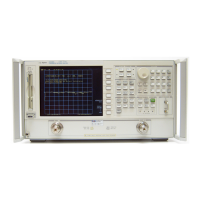4-12
Printing, Plotting, and Saving Measurement Results
Configuring a Plot Function
If You Are Plotting to a Pen Plotter
1. Press and then until
appears.
2. Configure the analyzer for one of the following plotter interfaces:
• Choose if your plotter has a GPIB interface, and then configure
the plot function as follows:
a. Enter the GPIB address of the plotter (default is 05), followed by .
b. Press and if there is no external controller
connected to the GPIB bus.
c. Press and if there is an external controller
connected to the GPIB bus.
• Choose if your plotter has a parallel (Centronics) interface, and then
configure the plot function as follows:
❏ Press and then select the parallel port interface function by pressing
until the correct function appears.
— If you choose , the parallel port is dedicated for normal
copy device use (printers or plotters).
— If you choose , the parallel port is dedicated for general
purpose I/O, and cannot be used for printing or plotting.
• Choose if your plotter has a serial (RS-232) interface, and then configure
the plot function as follows:
a. Press and enter the plotter's baud rate, followed by
.
b. To select the transmission control method that is compatible with your plotter,
press (transmit control - handshaking protocol) until the correct
method appears.
❏ If you choose , the handshake method allows the plotter to control
the data exchange by transmitting control characters to the network analyzer.
❏ If you choose , the handshake method allows the plotter to control
the data exchange by setting the electrical voltage on one line of the RS-232
serial cable.
NOTE Because the handshake takes place in the hardware rather than
the firmware or software, it is the fastest transmission control method.
Local
x1
Local
Local
Local
x1

